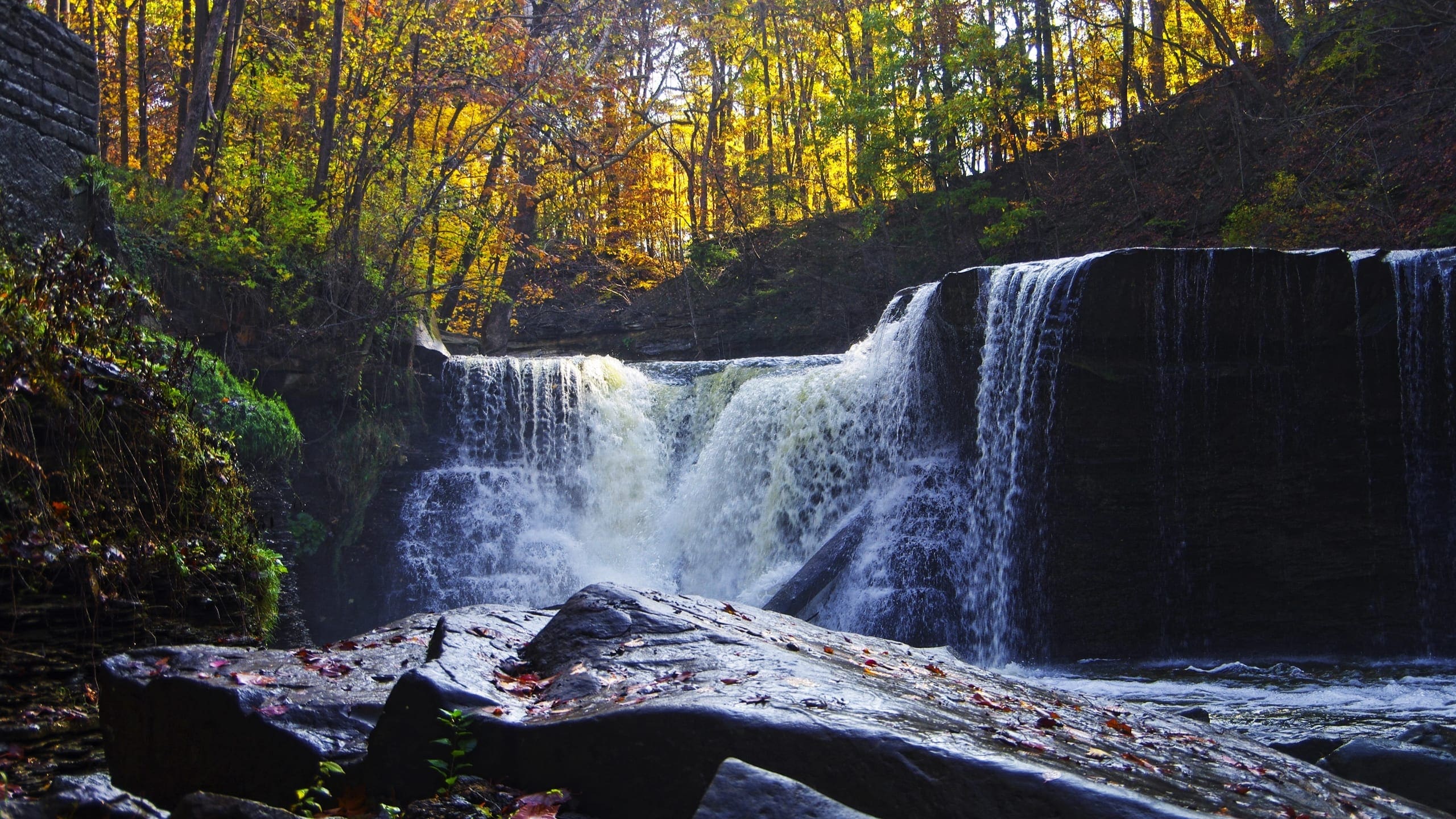About Cuyahoga Valley National Park
Cuyahoga Valley National Park encompasses 33,000 acres along the Cuyahoga River between Cleveland and Akron, Ohio. Its setting in a metropolitan area and its combination of scenic, natural, historic, recreational, and education values make it a well-loved gem in the national park system. Of the 33,000 acres, the National Park Service manages approximately 20,000 acres; the rest is held in other public and private ownership.
Established by Congress on December 27, 1974, as Cuyahoga Valley National Recreation Area, the area was renamed Cuyahoga Valley National Park on October 11, 2000. It was created during a time when the National Park Service emphasized a “Parks to the People” policy. Located within a one-hour drive of three to four million residents of northeast Ohio, it serves as a retreat for local urban dwellers, while also welcoming national and international visitors.
The park’s open space is vast for a metropolitan setting, increasing possibilities for preservation and restoration. Its topography and unique geographic position allows for rich biological diversity. The valley sits at the transition between major physiographic divisions of the country, the Appalachian Mountains and Great Plains, and near the southern edge of Ice Age glaciation. The valley’s uplands, steep slopes, moist ravines, and floor support mixed deciduous forests, wetlands, and other habitat types in a variety of stages of succession. These, in turn, provide a refuge for an assortment of plants and wildlife including rare, threatened, and endangered species. Some of the largest remaining forest tracts in northeast Ohio, stunning exposed rock ledges, and waterfalls all add to the natural scenery.
The Cuyahoga River drains into Lake Erie, part of the Great Lakes ecosystem and the largest system of fresh water lakes in the world. Once known as the “river that burned,” the Cuyahoga served as a symbol of the plight of America’s rivers and the need for federal clean water legislation. The beauty of its surrounding landscape and abundance of wildlife species today is in sharp contrast with the environmental abuses that occurred just a few decades ago.
The climate of the park is typical of northeast Ohio, having four distinct seasons. Summers can be hot and humid; winters cold and snowy. However, many temperate days occur year-round. Climate projections for the next 100 years forecast hotter temperatures and increased precipitation. Climate change could alter vegetation types from temperate mixed forest to temperate broadleaf forest. Invasive species, river water quality degradation, and flooding of historic structures present additional challenges that are currently occurring and expected to increase as a result of climate change.
The park contains hundreds of cultural assets including the Ohio & Erie Canal, the Valley Railway, and the historic communities of Everett, Peninsula, Boston, and Jaite. Historic farms, country roads, the Virginia Kendall State Park Historic District, and remnants of industry are diverse the cultural assets. The valley’s human story began when the modern valley landscapes began to evolve after glaciation, and American Indian peoples left their mark on the landscape through archeological sites and earthworks. American Indian cultures in the valley include those influenced by the Adena and Hopewell mound builders of southern Ohio, as well as the more localized Whittlesey tradition. The valley’s cultural assets include a continuum of transportation resources, many of which took advantage of the natural north-south corridor created by the valley. The variety of transportation-related resources documents the evolution of transportation and its impact on economies, communities, and daily life.
European American settlement patterns are another human influence on the landscape and broadly represent western migration. The valley briefly served as the edge of the newly formed United States when the 1795 Treaty of Greenville established the Cuyahoga River as the western boundary for settlement of the United States. By the mid-19th century, farms and villages dotted the valley landscape. Today, the park’s Countryside Initiative program focuses on the preservation of rural landscape while encouraging modern sustainable farming methods appropriate for a national park. Nearly a dozen of the farms, including historic buildings and associated lands, are managed to ensure continued agricultural use through long-term leasing under this program.
Visitors have numerous opportunities to enjoy the park and experience it as an authentic classroom. Park staff work closely with partners and compatible institutional landowners to provide educational and cultural programs, arts and crafts demonstrations, recreational and ranger-guided programs, and other special events. Recreational activities are available year-round and include hiking, excursion rail tours, fishing, running, bicycling, horseback riding, golfing, skiing, sightseeing and picnicking, bird-watching, and nature study.
Cuyahoga Valley National Park is a prime example of a partnership park that relies on the innovative contributions of its partners to achieve the purpose of the park to the highest degree possible. Partnerships enhance many park pursuits, including the rail and trail systems, public education, agricultural activities, resource conservation, and recreational activities and events. Compatible landowners and partners, including camps, county parks, ski areas, Blossom Music Center, and Hale Farm & Village, expand experiences offered within park boundaries. Volunteers are also active in park activities, contributing to trail patrols, park maintenance, interpretation and education, resource management, citizen science, visitor services, and more.
Consistently ranking among the top 10 most visited national parks in the country, Cuyahoga Valley National Park contributes to the quality of life within the region while protecting the resources within its boundaries. The Ohio & Erie Canal, a congressionally designated national heritage corridor, includes the park and extends beyond its boundaries to the north and south. Working in partnership with the National Park Service, it links the park directly to communities and expands opportunities for preservation and recreation.
Source: Foundation Document – Cuyahoga Valley National Park
Fast Facts:
| Date the Park was Established: | October 11, 2000 |
| Park Area (as of 2019): | 32,571.88 acres (131.8 km2) |
| Recreational Visitors (2018 Total): | 2096053 visitors |

